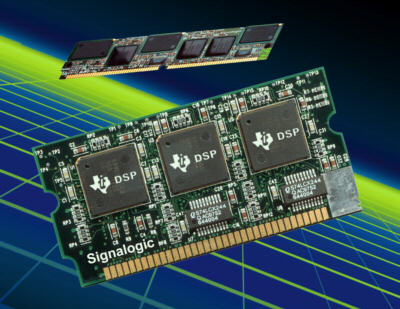Press Release for Texas Instruments Multi-DSP Modules
Return To SigC54x DSP Module Description Page
Return To Press Release Archives
Return To News Page
Return To DSP/Data Acquistion Hardware Page
Return To DSP Software Page
Little MIPS Monsters
DALLAS, TX (September 1999)— The
SigC54x multiprocessor modules pack up to 2400 MIPS and 12
Texas Instruments C54x DSP devices into very small form-factors. DSP types
available include Texas Instruments C549 and C5420;
module form-factors include SODIMM (2.5" x 1.25") and SIMM (4.75" x 1").
Module configurations can include a mix of DSPs and SRAM devices, in order to
provide additional program and/or data memory. DSP and SRAM device packaging
is BGA (ball-grid array) format. A development and test platform is
available with eight (8) module slots and ISA or PCI interface card
connection; the development platform is fully supported by the company's
DirectDSP, and
Hypersignal software. DirectDSP and Real-Time Composer™ software options include
direct access to multiple DSPs from C/C++, MATLAB, Visual Basic, and
LabVIEW, and also a signal-flow diagram environment with real-time DSP code
generation capability.
High MIPS density, low-power, and inexpensive multi-DSP solutions are in
growing demand in telecom, cellular communication, Internet routing
equipment, and IP telephony infrastructure products. Typical application
areas include base-station voice compression, echo cancellation, modem banks, and
voice-over-Internet. A modular approach allows straightforward upgrade of
telecom board products as new and faster DSP devices become available. The
company claims their current telecom and Internet routing equipment clients
use a modular DSP approach to build scalable systems and allow customer
upgrades to more voice channels.
For volume production, the company provides test and diagnostic services,
using the "DSTADS" DSP Test and Diagnostic
System.
Other Formats
Background Information
Information
Technical Contact: dspinfo (at) signalogic.com
Descriptions
The SigC54x-SODIMM and SigC54x-SIMM modules can be populated with
(1) to (12) C549 or C5420 DSPs and (1) to (12) 128k x 16 SRAM
devices. Processor clock speeds range from 100 MHz to 200 MHz (100 MIPS to 200 MIPS
per processor), depending on the DSP device type. SRAM devices
provide an additional 64k x 16 of both offchip Data and Program memory. Typically,
3-processor and 6-processor modules contain a mix of DSP and SRAM devices, and
12-processor modules contain no SRAM.
Serial interface (BSP, McBSP, and TDM) and host-port (HPI) interface signals are available
at the module edge connector. Modules can contain on-module shared clock oscillator,
or use off-module clock signals. On-module "cookie data" EEPROM option is available. JTAG signals are chained between DSPs and brought
out to the module edge connector.
Also available is a 4-channel 16-bit sigma-delta
SigSD4 Audio
Module" in SODIMM
form-factor, and an 8-channel module in SIMM form-factor. Audio Modules provide
to DSP devices multichannel speech and audio I/O at sampling rates from 8 to 48 kHz,
via direct, high-speed TDM (multi-drop) serial channel interface.
SigC54x modules are fully supported by the following off-the-shelf
software development packages:
The DirectDSP® software provides support for popular host programming
environments, including MATLAB, C/C++ (MSVC and
Borland), Visual Basic, and LabVIEW. See Software
Support below for more information.
Software Support
SigC54x modules, as well as other C54x platforms such as the Texas Instruments
DSK C54x, are supported by Signalogic off-the-shelf DSP software products designed for
DSP-based data acquisition and DSP code development, including:
Hypersignal®-Macro and Hypersignal-Acoustic
software series, which offer a number of simulation and real-time instrument functions.
Simulation functions include DSP and math functions, time domain display (including
waterfall, contour, magnitude, unwrapped phase), difference equation, digital FIR and IIR
filter design, sampling rate conversion, frequency zoom, wavelet transform, minimum phase
calculation, and many more. Instrument functions include spectrum analyzer, digital
oscilloscope, stimulus & response measurement, continuous signal generation, real-time
"snap-in" filtering, continuous disk record and generate, and more.
DirectDSP® is a Windows library which provides low-level
and high-level calls for user-defined C/C++, Visual Basic, MATLAB®, or LabVIEW® programs.
DirectDSP includes low-level board control functions such as reset/run/hold,
register access, block memory transfer, DSP executable file download, etc. High-level
functions include waveform file acquire/generate, continuous signal generation, and
execution of any arbitrary Hypersignal DSP or math function. DirectDSP includes
strip-chart recorder, digital oscilloscope and digital tape recorder demo program and
source code examples.
The C54x Source Code Interface software package
contains numerous C54x algorithms and functions in source and binary form,
such as optimized FFTs, filters,
matrix, transcendental, trig, signal manipulation function, board initialization
and analog I/O examples, etc. These functions form the basis of higher-level software
functions and instruments; modification can be used to customize Hypersignal or
DirectDSP operation. User-defined C routine hooks are provided for real-time algorithm
development. The Source Code Interface software can be used as a basic foundation for user-defined real-time DSP systems and products.
Click here for SigC54x Press Release in .doc format




